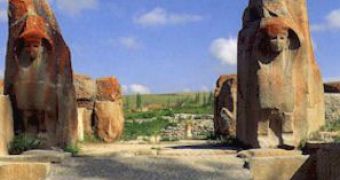The Hittites were mentioned even in the Bible. Their roots started with the Indo-European invasion in Anatolia (Asia Minor, now Turkey) 4,000 years ago. Around 1530 BC, the Hittites already made rapid invasions in the neighboring areas, and destroyed Babylon. By those times, Hittites were a warlike people involved in civil wars each time a king had to be named. But king Telepinu (1525-1500 BC) reformed the organization of the Hittites, creating an united state capable to defend against neighboring enemies, like the Hurrians and the Gasgas. Before this, all the Hittite cities were independent, each one having its own gods. The main Hittite god was Tarhun, the god of the sky and storm, always depicted seating on a pedestal made of two sitting lions.
For one century, the Hittites were dominated by the Mitanni kingdom of the Hurrians and the New Empire of the Egyptians. But during the 14th-13th centuries BC, they dominated Middle East.
After the peak epoch of Suppiluliuma I (1380-1340 BC), the Hittites resisted to the attacks of the 19th Egyptian dynasty, while Gangas invaded their kingdom 10 times during the 32 years of the rule of Mursili II.
The Hittite capital was located at Hattusas (now the Turkish village Boghazkoi), founded by the king Hattusil I (1650-1620). The city was raided and destroyed several times by the Gasgas, and rebuilt each time. Hittite houses were built on various levels, covered by a flat south-oriented roof.
The Hittite soldiers wore pointed or hemispheric helmets. The main weapons were the bow with the arrow, the spade, the spear, the shield and the ax. Hittites were famous for their iron processing and the beautiful adornment of their iron-made objects. In fact, they are the FIRST people known to process iron, and during the Neo-Hittite kingdom, during the 12th century BC, iron metallurgy spread from them to the whole Middle East. Iron revolutionized the weaponry.
Hittites also had swift chivalry units but they were skilled in fighting in covered places, like forests and swamps. They used light war chariots, dragged by two horses, that were very fast and could pass through mountains or narrow roads. Using these chariots, Suppiluliuma I conquered Damask in 1370 BC, then Syria, from Euphrates to the Mediterranean Sea in a very swift campaign. In 8 days, he conquered the city of Karchemish.
In the Hittite art, carnivorous mammals are omnipresent: lions, wolves, jackals and foxes. They were influenced by the Egyptians and the gate of the palace of Alaca Huyuc was decorated with a sphinx in the Egyptian style.

 14 DAY TRIAL //
14 DAY TRIAL //